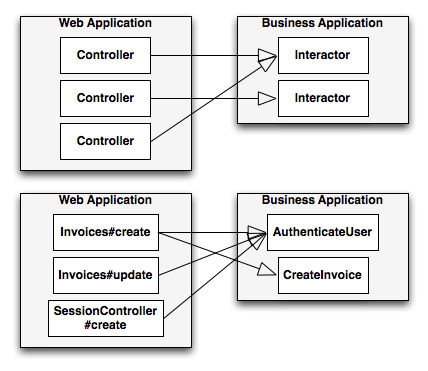Decoupling business logic from the web application
Uncle Bob’s talk inspired me to try to isolate away my business rules into a separate gem. Here was the concept I came up with (more or less):
SApp Gem Directory Structure
... other gem crap ... |-- lib | `-- sapp | `-- authenticate_user.rb | `-- display_receipt.rb | `-- finish_account.rb | `-- finish_transaction.rb | ... more use cases/interactors ... | `-- sapp.rb |-- test | `-- authenticate_user_test.rb | `-- display_receipt_test.rb | `-- finish_account_test.rb | `-- finish_transaction_test.rb | ... more use cases ... ... other gem crap ...
lib/sapp/authenticate_user.rb
module SApp
module AuthenticateUser
class << self
attr_reader :action
def authenticate(account, username, password)
@account, @username, @password = account, username, password
find_account
if account_found? && valid_credentials?
view_success
else
view_login_error
end
end
# some methods like this:
def account_found?
end
def user_found?
end
def valid_credentials?
end
### etc ###
private
def find_user
@user = account.find_account(@username)
end
end
end
endNow you can imagine that my code could be interacted with from a rails controller or a sinatra application or a desktop application with this API:
Rails Example
class SessionController < ApplicationController
before_filter :find_account
def create
authenticate = SApp::AuthenticateUser.authenticate(account, params[:username], params[:password])
action = authenticate.action
if action != :login_error
redirect_to "/#{action}"
else
flash[:error] = "Login failed"
redirect_to :back
end
end
protected
# @account_subdomain extracted from the subdomain elsewhere. That logic should remain in the web application
def find_account
@account = SApp::FindAccount.find(@account_subdomain)
end
endSinatra Example
before '/authenticate' do
@account = SApp::FindAccount.find(@account_subdomain)
end
post '/authenticate' do
authenticate = SApp::AuthenticateUser.authenticate(@account, params[:username], params[:password])
action = authenticate.action
if action != :login_error
redirect to("/#{action}")
else
flash[:error] = "Login failed"
redirect to('/')
end
endtest/authenticate_user_test.rb
require 'test_helper'
describe SApp::AuthenticateUser do
describe "authenticate" do
let(:account) { FactoryGirl.create(:account) }
let(:user) { FactoryGirl.create(:username, :account_id => account.id) }
describe "user_found?" do
before do
user
end
it "is true when the username matches a user on the account" do
authenticate = SApp::AuthenticateAccount.authenticate(account, "testusername", "testpassword")
authenticate.user_found?.must_equal true
end
it "is false when the username cannot find a user on the account" do
authenticate = SApp::AuthenticateAccount.authenticate(account, "notfoundusername", "testpassword")
authenticate.user_found?.must_equal false
end
end
end
### ... more tests ... ###
endIt is important to note that I intentionally did not pass the entire params hash to the interactor. The interactor should explicitly specify the required parameters it needs to complete the use case. As a result of this new design, I don’t need to write acceptance tests that run through the web application because my core business layer has been decoupled and the API that my web application interacts with is dumb and dead simple.
I intentionally left out the Entities from my examples and you might also notice that I am making calls to the database from my use cases. I will explain my reasoning in the next chapter on my quest for a better architecture… which is coming soon.
Here is a high level diagram of the idea:

As always, feedback is appreciated!